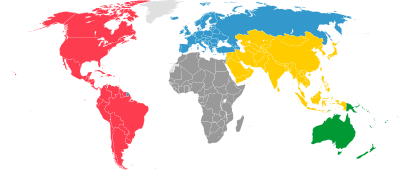Basketball in the Philippines
Basketball is the most popular sport in the Philippines, played on both the amateur and professional levels.
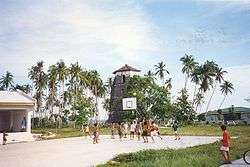
History
| Part of a series on the |
| Culture of the Philippines |
|---|
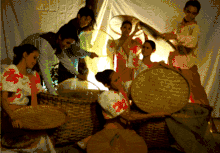 |
|
| People |
| Languages |
| Traditions |
| Cuisine |
| Festivals |
| Religion |
| Art |
| Literature |
|
Music and performing arts |
|
Media |
|
Monuments
|
|
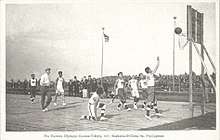
Basketball was introduced in the Philippines during the American colonial period with the first American teachers teaching the sport along with baseball through the YMCA and the school system.[1] Basketball was first introduced to the Philippine public school system by the Americans as a women's sport in 1910 and was played in Interscholastic meets in 1911 until 1913. Women's basketball met opposition from conservative groups, particularly the Catholic Church who view bloomers worn by women basketball players as inappropriate. By the time skirts were allowed to be worn above bloomers as a compromise, women's basketball was already in decline and was only played in provincial and local interscholastic meets. Indoor softball and as well as volleyball became the more preferred sport for Filipino women.[2]
The first men's national team – organized in the 1910s – won the first Far Eastern Championship Games in 1913. In all but one of the ten editions of the games, the national team won the gold medal.[1]
The National Collegiate Athletic Association (NCAA), which had basketball as its main sport, was established in 1924.[1]
The Philippines became a member of FIBA through the Basketball Association of the Philippines in 1936. The Philippines made their debut in the Olympic Games in 1936 where they finished fifth, the best result of an Asian team in Olympic basketball history. In the same year, the first basketball stamp in the world was released by the country. The first commercial league was the basketball tournament of the Manila Industrial and Commercial Athletic Association (MICAA) which was established in 1938.[1]
The Philippines became an independent country in 1946, and in the 1950s, the national team did well in international tournaments. The Philippine team won the gold medal at the Asian Games in 1951, the first-time basketball was played.[3] The Philippine basketball team dominated the Asian Games until 1962.[3] In the 1954 FIBA World Championship the Philippines placed third, winning the bronze medal, the best performance by an Asian team in the World Championship.
After missing the first FIBA Basketball World Cup (known through 2010 as the FIBA World Championship) that was held in 1950 in Argentina, the Philippines participated in the 1954 FIBA World Championship held at Rio de Janeiro, Brazil. The Philippines finished with a 5–2 win-loss record in the Final Round games, and captured the bronze medal. The third place-finish is still currently the best finish by an Asian country in the World Cup. Carlos Loyzaga finished as the world tournament's third leading scorer (148 points/16.4 points per game) and was named in the FIBA World Mythical Five Selection.
In the 1960s, the first FIBA Asia Championship was won by the Philippines with Carlos Badion as the tournament's Most Valuable Player.
Meanwhile, the Philippines won the right to host the third FIBA World Championship, but were suspended after then-President Diosdado Macapagal, father of former President Gloria Macapagal-Arroyo, refused to issue visas to players from communist countries (notably basketball powerhouse Yugoslavia and the Soviet Union).
The Philippines' dominance in sport waned after Carlos Loyzaga's retirement, and had performed poorly in the Olympic games where the national team was unable to break into top-10 positions. However, the country continued to play competitively in the Asian and World Championships.
The commercial league model pioneered by the MICAA continued with the Philippine Basketball Association (PBA) in 1975 and the Philippine Amateur Basketball League (PABL) in 1983. The PBA is the first professional basketball league in Asia and the second oldest in the world after the NBA.[4] The league's regulations are a hybrid of rules from FIBA and the NBA. The league was inaugurated on April 9, 1975.[5] The PABL was established to fill the void created after the collapse of the MICAA in 1981.
In 1978, the Philippines hosted the FIBA World Championship, marking the first time that the international tournament was held in Asia.
The Philippines was suspended by FIBA in 2005 due to a leadership crisis which affected the former national basketball association of the country – the Basketball Association of the Philippines.
In 2007, the Samahang Basketbol ng Pilipinas became the newly-recognized national basketball body for the Philippines by FIBA.
National teams
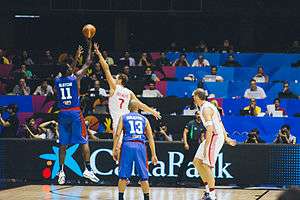
- Senior
- Men's (in FIBA club tournaments)
- Women's
- Men's 3x3
- Men's wheelchair
- Youth
- Boys' under-19
- Girls' under-19
- Boys' under-17
- Girls' under-17
- Universiade
Leagues
Men's
- Professional
- Philippine Basketball Association (since 1975)
- ASEAN Basketball League (since 2009)
- Semi-Professional
- Maharlika Pilipinas Basketball League (since 2017)
- Amateur
- PBA Developmental League (since 2011)
- UNTV Cup (since 2013)
- National Basketball League (since 2018)
- Metro League (since 2018)
- Community Basketball Association (CBA-Pilipinas) (since 2019)
- Collegiate
- Philippine Collegiate Champions League (since 2002)
- NCAA Basketball Championship (since 1924)
- UAAP Basketball Championship (since 1938)
- Cebu Schools Athletic Foundation, Inc.(since 2001)
- National Athletic Association of Schools, Colleges and Universities (since 2001)
- National Capital Region Athletic Association (since 1993)
- Filoil Flying V Preseason Premier Cup (since 2006)
- Universities and Colleges Basketball League (since 2016)
- Father Martin Cup (since 1994)
- Defunct
- Manila Industrial and Commercial Athletic Association (1938–81)
- Metro Manila Tiong Lian Basketball Association (1971–2013)[6]
- Philippine Basketball League (1983–2011)
- Metropolitan Basketball Association (1998–2002)
- Mindanao Visayas Basketball Association (2006–08)
- United Regional Basketball League (2004–05)
- National Basketball Conference (2004–08)
- Liga Pilipinas (2008–11)
- Pilipinas Commercial Basketball League (2015–16)
- Filsports Basketball Association (2015–16)
- Country-Wide Basketball League (2016)
Publications
- XVII Intercontinental Cup – Girona/Barcelona 1985
- Bocobo, Christian and Celis, Beth, Legends and Heroes of Philippine Basketball, (Philippines, 2004)
- Dela Cruz, Juan, Book of Pinoy Facts and Records, (National Bookstore, Mandaluyong City, Philippines, 2004)
- Philippine Basketball Association, The First 25 Years, (Philippines, 2000)
References
- Henson, Joaquin (2016). "Why Filipinos love basketball". The Philippine Star2. Retrieved September 26, 2017.
- Antolihao, Lou (2015). "Spheroid of Influence: Sports, Colonization, Modernity – Ballers in Bloomers:Sports, Gender, Participation". Playing with the Big Boys: Basketball, American Imperialism, and Subaltern Discourse in the Philippines (Illustrated ed.). University of Nebraska Pres. ISBN 0803278519. Retrieved September 26, 2017.
- Pamintuan, Carlo (September 29, 2014). "The Philippines headed for worst-ever Asian Games finish in basketball". Yahoo PH Sports. Retrieved December 8, 2014.
- Bartholomew, Rafe. "Pacific Rims". New American Library, 2010, p. 13.
- Bartholomew 2010, p. 13.
- https://www.facebook.com/Metro-Manila-Tiong-Lian-Baskteball-Association-281680648556912
External links
| Wikimedia Commons has media related to Basketball in the Philippines. |
